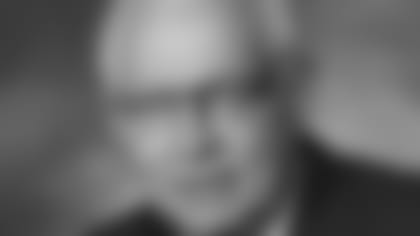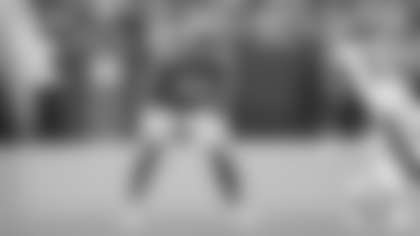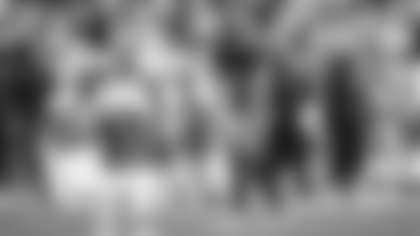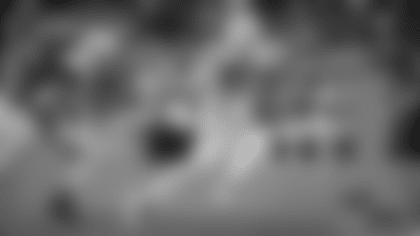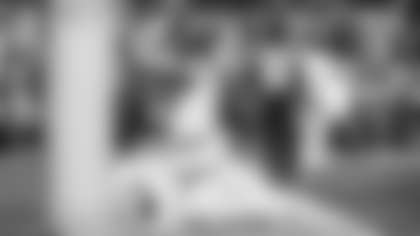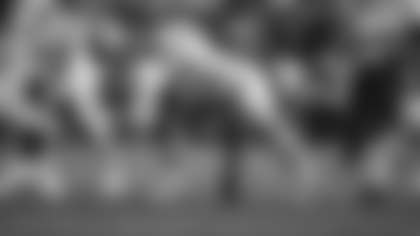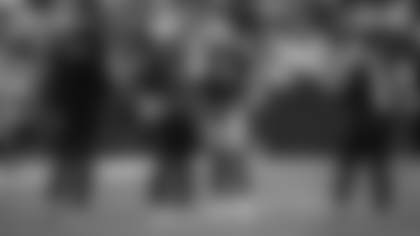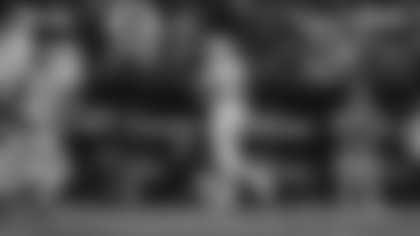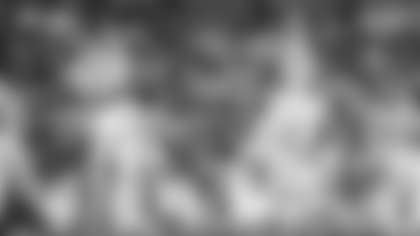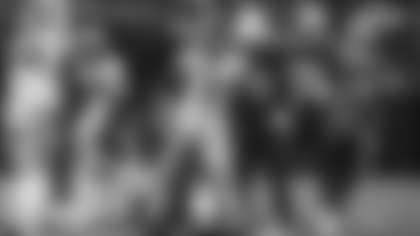Lee, I was wondering if anyone filmed the "Ice Bowl". If so, is there a place that fans can go to watch it? - Andrew, Madison, Wis.
Dear Andrew: The "Ice Bowl" indeed was filmed and a video of that classic contest is available for viewing in the Packers Hall of Fame during daily business hours, at no additional charge above regular admission. The HOF, of course, is located within the Packers administration building (1265 Lombardi Ave., Green Bay).
I have only been able to see one Packers game at Lambeau Field. I believe it was in 2001 vs. the Colts. I was blessed to have partaken in real Packers weather that day. What is the Packers record when they play in snow? Has a Packer game ever been delayed or cancelled due to snow? - Tyler, Decatur, Ga.
Dear Tyler: It would be difficult to compile an accurate "in-the-snow" won-lost record for the Packers over their 80-plus years of competition, depending upon what snowfall "numbers" might be used to determine what would qualify as a so-called snow game.
But, on this subject, then Green Bay Press-Gazette sports editor Art Daley observed in his day-after-the-game story of the Packers' NFL championship game against the Cleveland Browns in Green Bay on Jan. 2, 1966: "Two hours before kickoff, you wondered if it was possible to play, what with a four-inch snowfall, but the field was swept off and it was in excellent condition, although intermittent rain and snow softened the turf."
Amazingly, Daley further noted, "Despite the weather danger, the two teams never fumbled all afternoon - a tribute to the intense desire on both sides."
In 1954, we drafted Bob Fleck in the second round, a highly touted tackle out of Syracuse. However, Fleck does not appear on the team roster for that year. What became of him at the time? - Steve, Owatonna, Minn.
Dear Steve: As you will readily gather from the contents of his letter to then Packers Head Coach Ray "Scooter" McLean, Bob Fleck obviously had a change of heart about playing professional football - after signing a Green Bay contract.
In his letter to McLean, dated May 5, 1954, he wrote, "After much consideration, I realize that I was a little hasty in signing a contract with Green Bay. I have decided not to play football in the National Professional Football League this year."
He added, "I am sorry if I have caused you to waste any time or undue expense in my behalf.
"I know that Green Bay has many good tackles and my presence will not be missed.
"I am enclosing the check which you so graciously advanced to tide me over until this fall," Fleck concluded, adding, "I certainly want to wish you the best of luck this fall and hope Green Bay wins the National League title."
A lot of emphasis is put on player evaluations in the NFL Draft in that players can be labeled a "can't-miss prospect" and so on. Sometimes these evaluations prove to be accurate and sometimes they are quite the contrary. What were the player evaluations for Brett Favre when he was entering the draft? - Robert, Kansas City, Mo.
Dear Robert: I went to several sources on our staff seeking a definitive answer to this question, but two of them weren't able to provide one, not having been around when Favre, now a 17-year professional, was coming into the draft.
Lionel Washington, who is responsible for the Packers' defensive nickel package and the cornerbacks, and who also is going into his 17th NFL season, had no reservations. Of Favre, he said, "I think Brett was a highly regarded football player coming into the draft in 1991." He added, "And in his first year in Green Bay (1992, Favre's second NFL season) I thought he was one of the most competitive football players I had ever seen." The following year, Washington was with the then-Los Angeles Raiders when they faced the Packers in Lambeau Field and Washington had to be further impressed as Favre led the Green and Gold to a 28-0 victory over the Raiders.
Being a "transplanted" Packers fan living in Minnesota, I wanted to see how many games the Packers played against the Vikings in Milwaukee. Also, how many games did the Packers win at County Stadium during Lombardi's tenure? - Jim, St. Cloud, Minn.
Dear "Transplanted": The Packers had slightly the better of it against the Vikings in games played at Milwaukee County Stadium (a venue which no longer exists). Beginning in 1961 and ending in 1993, the Packers played the Minnesotans 15 times in Milwaukee, winning nine games and losing six, and outscoring the Vikings, 278 points to 220 in the process. (The Packers no longer play games in Milwaukee and haven't since 1994.)
Do you recall a Packers player by the name of Orrin Pape from 1930? Do you know what ever happened to him? - Dennis, Menominee, Mich.
Dear Dennis: The record shows that the Packers signed Orrin Pape, a halfback, in 1930 and he played in eight games for Green Bay. (His first name, by the way, is spelled "Oran" in the encyclopedia, Total Football.) He later played for at least two other NFL teams, one of them the Providence SteamRollers. Pape, born in 1904, died in 1936 at the age of 32.
Mr. Remmel, I remember at one time the Packers played at Camp Randall in Madison but I think they were only pre-season contests and I can't find much information about them. Can you tell me who the Pack played in Madison and what their record was at Camp Randall? - Mitch, Locust Grove, Okla.
Dear Mitch: You are right -- the Packers did play a total of 12 preseason games at the University of Wisconsin's Camp Randall Stadium in Madison, beginning in 1986 and ending in 1999. They won nine of them, including two out of three from both the New York Jets and the New Orleans Saints, two from the Buffalo Bills and single contests from the New York Giants and the Denver Broncos.
Their three losses, for the record, were to the Washington Redskins and, to, of course, the Jets and Saints.
Incidentally, the Packers' 27-12 victory over the Giants on Aug. 23, 1999 - in the last of those preseason contests at Camp Randall - was witnessed by 78,184 fans, the largest crowd ever to attend a Packers game in the state of Wisconsin.
My question has to do with the transition of authority after Phil Bengston. Who made the decision to hire Dan Devine? I remember Dave Hanner feeling slighted for not receiving the position. Also, wasn't the general manager position part of the head coaching responsibilities until it was removed from Bart Starr? Was Devine solely responsible for the John Hadl trade? - Joel V., Bradenton, Fla.
Dear Joel: The Packers Executive Committee, headed by President Dominic Olejniczak, hired Dan Devine as head coach and general manager on Jan. 14, 1971.
Devine subsequently was dismissed on Dec. 16, 1974, after compiling a 25-28-4 won-lost record.
Yes, Devine was solely responsible for executing the trade for quarterback John Hadl, who was acquired from the Los Angeles Rams for five high draft choices (two firsts, two seconds and a third) in October of 1974.
The position of general manager was not necessarily part of the head coaching responsibilities at the time, by the way. The positions were structured as a dual role when Vince Lombardi joined the Packers in February of 1959, but when Lombardi stepped down as head coach following the Packers' victory over Oakland in Super Bowl II, Lombardi retained the title and authority of general manager. The dual title then was restored when Devine signed on in January of 1971 as head coach and general manager. The arrangement was continued when Bart Starr succeeded Devine on Dec. 24, 1974. Starr later was relieved of his duties as general manager on Dec. 28, 1980, and continued as head coach through the 1983 season. He was relieved of his head coaching duties Dec. 19, 1983.
Hi Lee, Seeing the picture of A.J. Hawk throwing the first pitch at Miller Park and reading about his visit with the Brewers got me thinking about others Packers who did stints in the majors or minor leagues. Through the years, have any Packers before, during or after their football careers played pro (or semi-pro) baseball? - David, Pleasant Hill, Wis.
Dear David: Fullback Ted Fritsch, for one, played baseball at the Triple-A level as an outfielder for the Toledo Mudhens of the American Association, among others.
Strong safety Tom Brown, of the Packers' NFL triple champions (1965-66-67), also tried his hand at professional baseball with the Baltimore Orioles before joining the Packers full-time in 1964. Brown had been a second-round draft selection as a safety, out of the University of Maryland, in 1963.
Pro Football Hall of Famer Cal Hubbard did not attempt to play baseball, but he was good enough at "calling" the game to eventually become umpire-in-chief of the American Baseball League and the only man to have been inducted into both the Pro Football and Major League Baseball Halls of Fame.
Packers founder Curly Lambeau also tried his luck at baseball as a young athlete on area diamonds and was known for his ability to hit the "long ball."
Who was the first black minority player to play for the Packers? I believe it to be Nate Bourdon, a defensive lineman in the mid-1950s. Also, it is my understanding that of the 12 teams of that era, the Redskins were the last team to sign black players. Is this accurate? - Dale, Mosinee, Wis.
Dear Dale: Bob Mann, an end from the University of Michigan, was the first African-American to play in an NFL game for the Packers. Drafted by Detroit in 1948, Mann was released by the Lions in 1950 and signed by the Packers as a free agent. He went on to become the Packers' leading receiver is 1951 (50 receptions for 696 yards and eight touchdowns), subsequently closing out his career with the Green and Gold in 1954.
Nate Borden, also an African-American, likewise played for the Packers but the University of Indiana alumnus didn't come along until 1955, when he was a 25th round draft pick, the 293rd player chosen. He closed out his career in 1959, Vince Lombardi's first year in Green Bay.
Dan Knight was drafted in 1986 with the 98th pick out of San Diego State. What ever happened to him? - Jim, Sacramento, Calif.
Dear Jim: As a practical matter, 1986 draftee Dan Knight never played for the Packers in a league game. The 98th player chosen in the '86 draft, he spent the season on reserve/non-football illness. A year later, he was placed on injured reserve at the start of the 1987 season and subsequently placed on waivers, in effect ending Knight's career.
Lee, I think Tobin Rote was probably the most instrumental player for Green Bay in the 1950s in keeping the franchise in Green Bay during that troubled era. Would you concur or would you have another choice? - Jigger, Las Vegas, Nev.
Dear Jigger: Tobin Rote was a talented and productive football player on a succession of mediocre Packers teams in the 1950s. Despite those limiting circumstances, he led the team in rushing three of his seven seasons in Green Bay.
And, further documentation of his skills, the year he was traded to the Detroit Lions (1957), he led them to the NFL Championship (the last time, incidentally, that Detroit won an NFL league title).
In your opinion, what was the greatest Packers team under the Lombardi reign? - Frank, Las Vegas, Nev.
Dear Frank: I would have to vote for the 1962 team as the greatest Packers team under Lombardi, in part because the Green and Gold posted the best record in team history (13-1) and, in the process, set team records for most points scored (415) and fewest points allowed (only 148).
Why did Vince Lombardi trade Paul Hornung to the Saints? - Matt, Dousman, Wis.
Dear Matt: Specifically speaking, Vince Lombardi did not trade Pauil Hornung to the New Orleaans Saints. Personally very fond of Hornung, Lombardi did not want to let the Golden Boy go to any other team but reluctantly placed Paul in the expansion draft of players to the fledgling Saints, knowing full well that Hornung had no intention of playing because of a neck injury which, in effect, ended his career.
Mr. Remmel, what can you tell us about the game against the Lions in 1945 when Don Hutson scored 29 points in the 2nd quarter? I don't think that NFL record will ever be broken! - Dan, Oconomowoc, Wis.
Dear Dan: I had the privilege of sitting in on that game - a spectacular offensive show by the Packers - Don Hutson, primarily, I should say. He caught four touchdown passes (from tailback Roy 'Tex' McKay) and kicked five extra points to post that 29-point second-quarter eruption against the Detroit Lions at State Fair Park in the Milwaukee area.
The Packers trailed the Lions early in the second quarter, 7-0, before exploding for 41 consecutive unanswered points, a total which is still an NFL record for most points in one quarter, although once-tied. The Packers led the Lions, 41-7, at halftime. Oddly enough, the "tying" 41-point total by the Los Angeles Rams also was registered against the Lions, on Oct. 29, 1950, in the third quarter of their game.
Hutson's 29 points remain the most ever scored by one player in one quarter of an NFL game.
And the Packers' 57 points (in a 57-21 victory) remain, to this day, the most points they ever have scored in a single regular-season game.
Hi Lee, On Sept. 9, 1935, Johnny Blood McNally played for the LaCrosse Lagers vs. the Packers in a non-league game. How did he convince Curly to re-sign him? - Mark, LaCrosse, Wis.
Dear Mark: I don't know how Curly convinced Blood to re-sign with the Packers but Johnny could be very persuasive.
I presently live in Georgia, and the tale here is that the Packers logo "G" was taken, without consent, from the Georgia Bulldogs. It is said that the Packers (which I don't believe), had to pay for a copyright infringement. Is there any truth to this Georgia tale? - Don, Brunswick, N.D.
Dear Don: My understanding is that the Packers first adopted the distinctive "G" logo they feature in 1961. It also is our understanding that the University of Georgia followed suit in 1964 - after obtaining permission from the Packers organization.
In the early Packers years, what kind of transportation did the team use? Did they have a Packers Bus? Or, were they fortunate to have train service to away games like New York? - Jay, Ft. Wayne, Wis.
Dear Jay: The Packers had access to train service (principally the Chicago and North Western, along with the Milwaukee Road for trips to Milwaukee).
But Coach Curly Lambeau, a progressive sort, developed a yen for air travel early on and the story goes, became the first NFL coach to fly his team to a road game, presumably as early as 1938.
League officials, meanwhile, were so concerned about the possibility of an air disaster that they required the Packers to travel their squad in two DC-3 airplanes, half of the team in one DC-3 and the remaining half in the other.
Continuing an association with the team that is more than 55 years old, Lee Remmel was named the first official Team Historian of the Green Bay Packers in February 2004. The former *Green Bay Press-Gazette reporter and Packers public relations director, Remmel will write regular columns for Packers.com as part of his new assignment.
In addition to those articles, Remmel will answer fan questions in a monthly Q&A column. To submit a question to Remmel, click here. *


